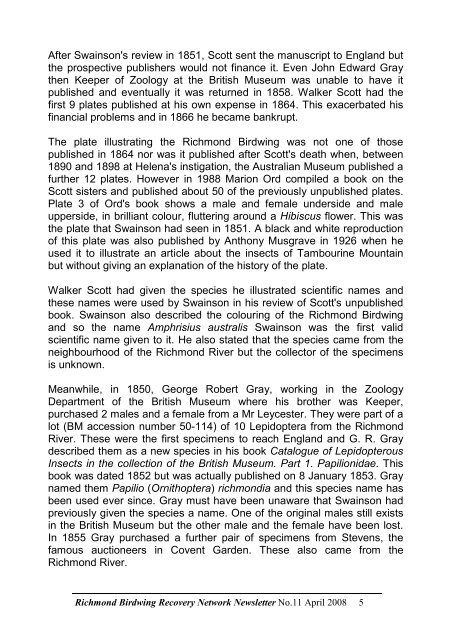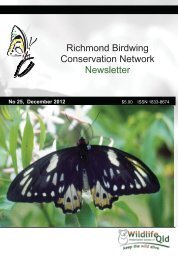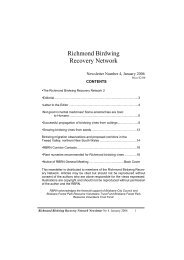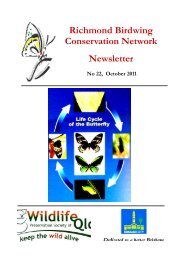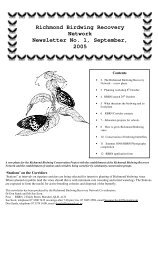Richmond Birdwing Recovery Network Inc.
Richmond Birdwing Recovery Network Inc.
Richmond Birdwing Recovery Network Inc.
You also want an ePaper? Increase the reach of your titles
YUMPU automatically turns print PDFs into web optimized ePapers that Google loves.
After Swainson's review in 1851, Scott sent the manuscript to England but<br />
the prospective publishers would not finance it. Even John Edward Gray<br />
then Keeper of Zoology at the British Museum was unable to have it<br />
published and eventually it was returned in 1858. Walker Scott had the<br />
first 9 plates published at his own expense in 1864. This exacerbated his<br />
financial problems and in 1866 he became bankrupt.<br />
The plate illustrating the <strong>Richmond</strong> <strong>Birdwing</strong> was not one of those<br />
published in 1864 nor was it published after Scott's death when, between<br />
1890 and 1898 at Helena's instigation, the Australian Museum published a<br />
further 12 plates. However in 1988 Marion Ord compiled a book on the<br />
Scott sisters and published about 50 of the previously unpublished plates.<br />
Plate 3 of Ord's book shows a male and female underside and male<br />
upperside, in brilliant colour, fluttering around a Hibiscus flower. This was<br />
the plate that Swainson had seen in 1851. A black and white reproduction<br />
of this plate was also published by Anthony Musgrave in 1926 when he<br />
used it to illustrate an article about the insects of Tambourine Mountain<br />
but without giving an explanation of the history of the plate.<br />
Walker Scott had given the species he illustrated scientific names and<br />
these names were used by Swainson in his review of Scott's unpublished<br />
book. Swainson also described the colouring of the <strong>Richmond</strong> <strong>Birdwing</strong><br />
and so the name Amphrisius australis Swainson was the first valid<br />
scientific name given to it. He also stated that the species came from the<br />
neighbourhood of the <strong>Richmond</strong> River but the collector of the specimens<br />
is unknown.<br />
Meanwhile, in 1850, George Robert Gray, working in the Zoology<br />
Department of the British Museum where his brother was Keeper,<br />
purchased 2 males and a female from a Mr Leycester. They were part of a<br />
lot (BM accession number 50-114) of 10 Lepidoptera from the <strong>Richmond</strong><br />
River. These were the first specimens to reach England and G. R. Gray<br />
described them as a new species in his book Catalogue of Lepidopterous<br />
Insects in the collection of the British Museum. Part 1. Papilionidae. This<br />
book was dated 1852 but was actually published on 8 January 1853. Gray<br />
named them Papilio (Ornithoptera) richmondia and this species name has<br />
been used ever since. Gray must have been unaware that Swainson had<br />
previously given the species a name. One of the original males still exists<br />
in the British Museum but the other male and the female have been lost.<br />
In 1855 Gray purchased a further pair of specimens from Stevens, the<br />
famous auctioneers in Covent Garden. These also came from the<br />
<strong>Richmond</strong> River.<br />
<strong>Richmond</strong> <strong>Birdwing</strong> <strong>Recovery</strong> <strong>Network</strong> Newsletter No.11 April 2008 5


